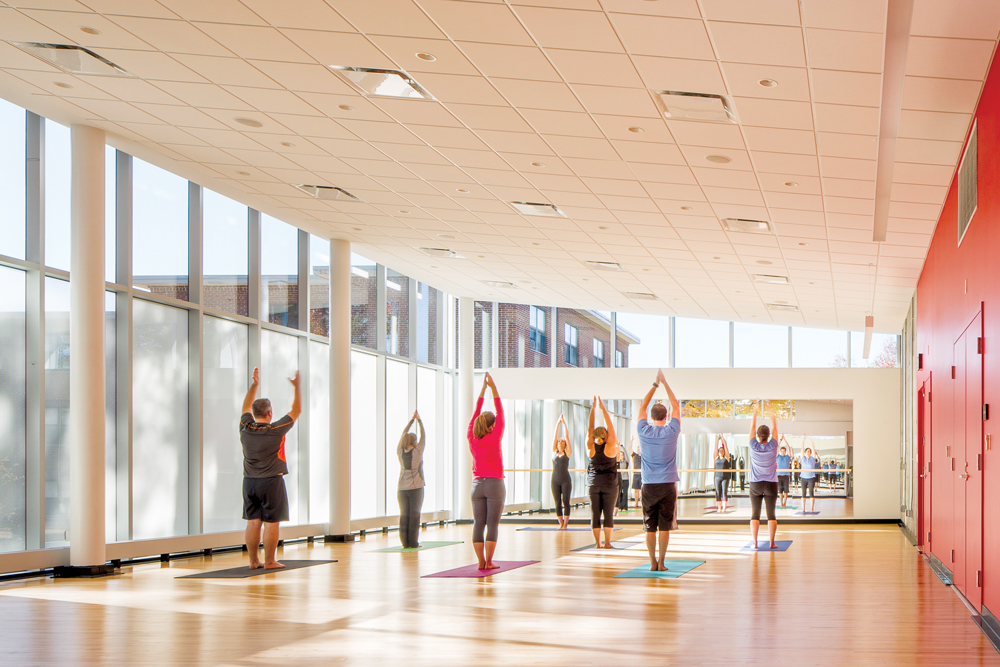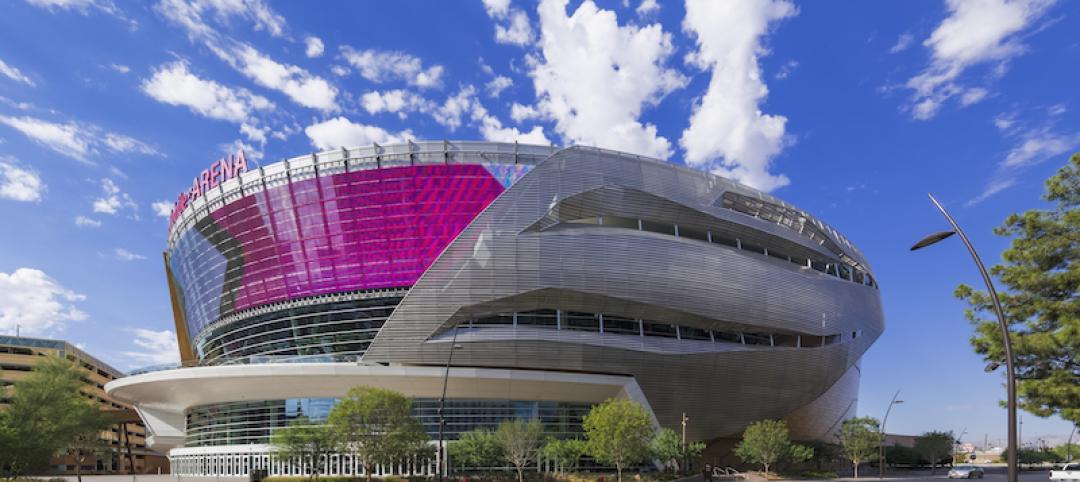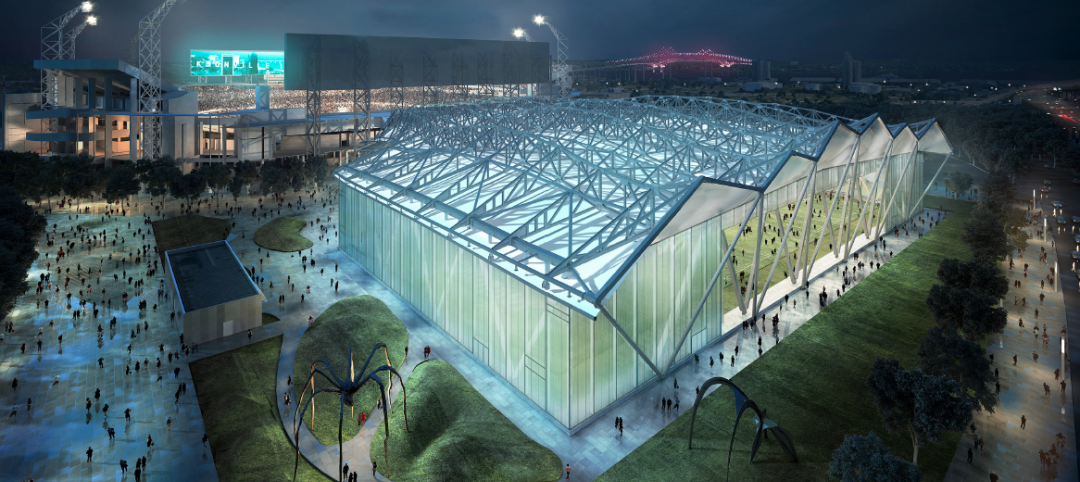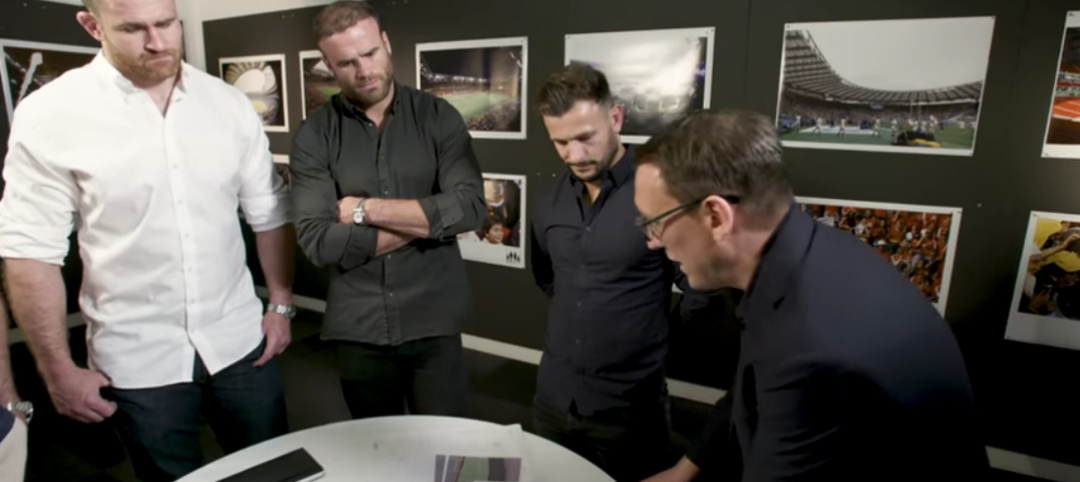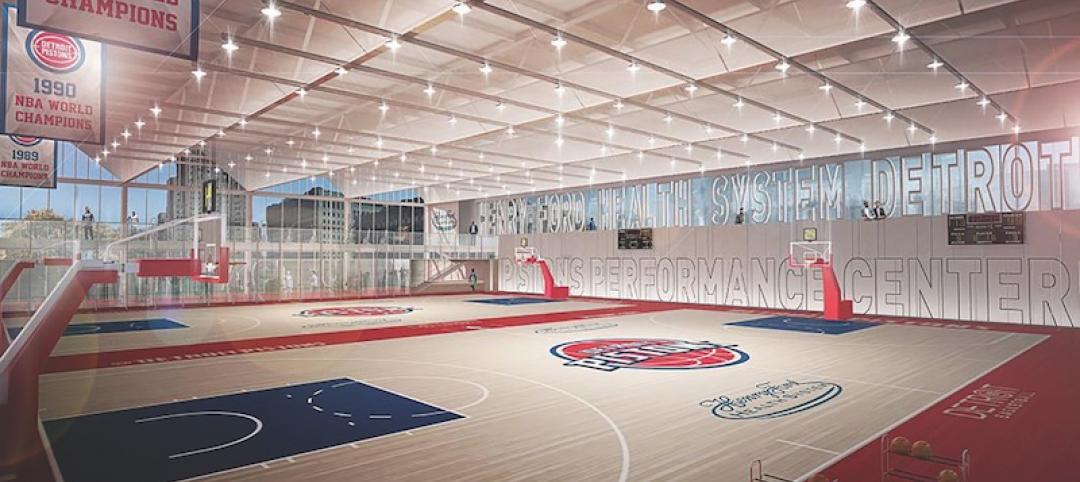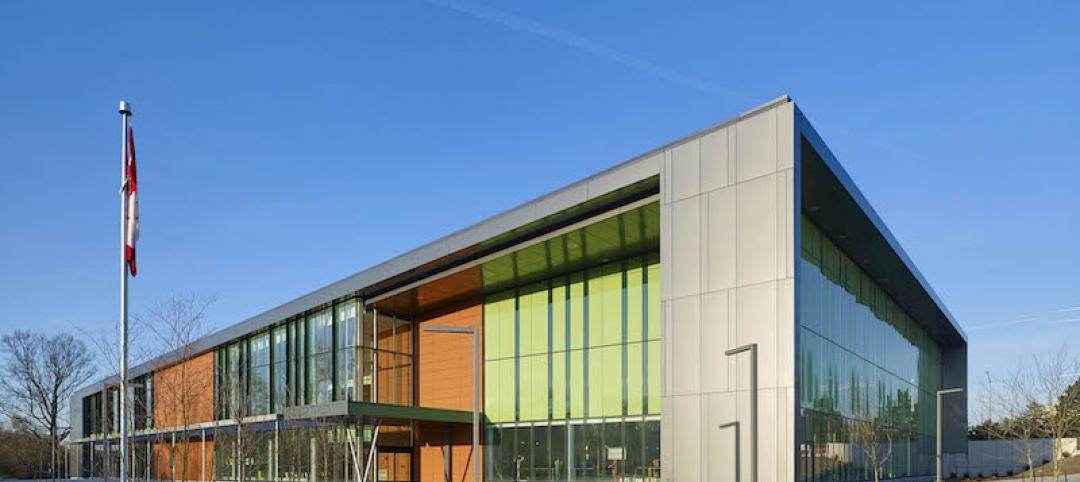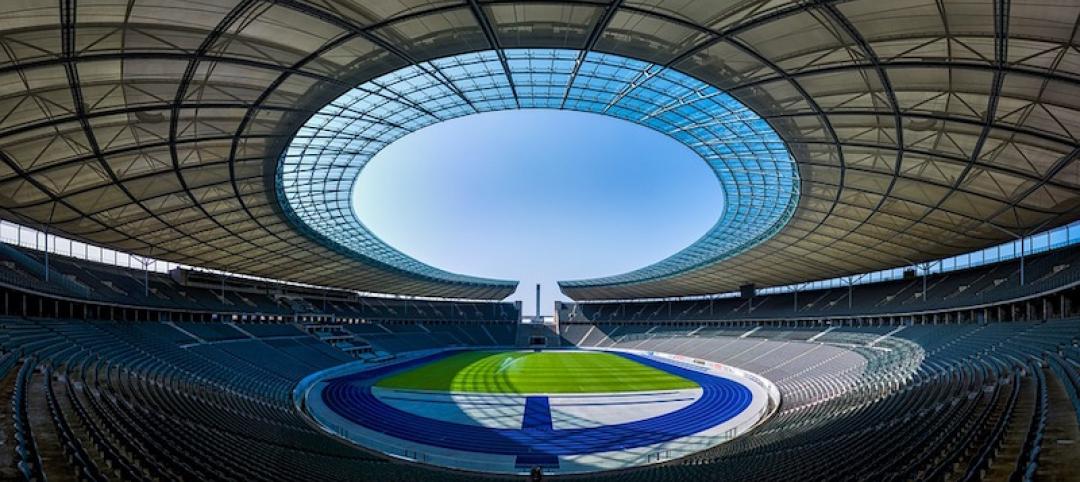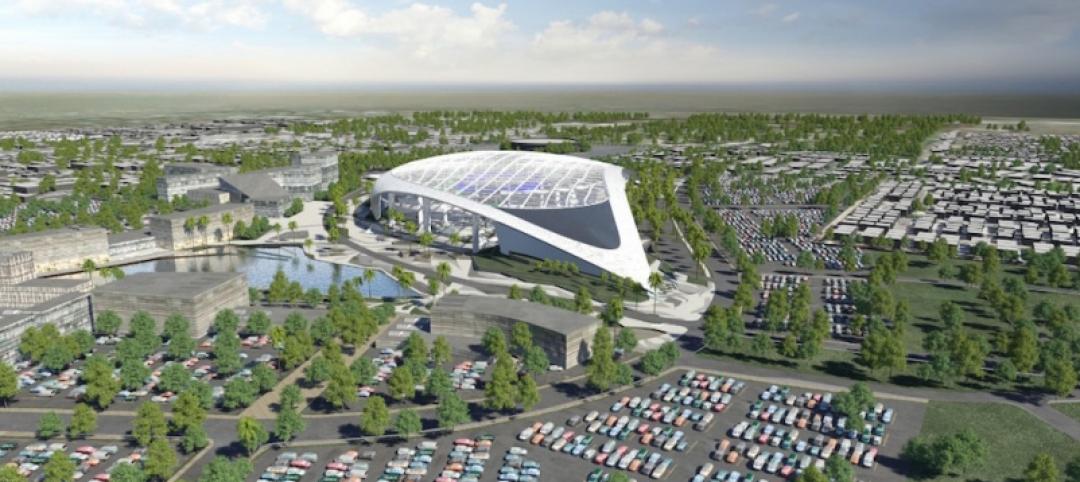Sports and recreation used to be confined to dedicated, often isolated, settings. That’s no longer the case. Adopting facility layouts from Asian and European models, today’s sports and recreational buildings are becoming social hubs that accommodate a variety of community needs, whether in a city center, on a college campus, or at a suburban recreational complex.
The idea is to nurture communities and social interaction by expanding the sports/recreation program to a wider range of uses and users, while embracing current health and wellness concerns. This shift establishes a much broader agenda that considers body, mind, and spirit as a whole. On university campuses and at public and independent secondary schools, sports and wellness facilities have surpassed student unions and arts centers to become the focal point of social interaction.
LEARNING OBJECTIVES
After reading this article, you should be able to:
+ List up to three factors that are changing the needs, designs, and construction approaches for athletic and recreation centers.
+ Discuss the planning and design principles used to establish the relationship of the facilities within a campus or urban context, and how factors such as solar orientation affect the building’s design.
+ Explain how integrated design and sustainable design approaches are impacting the development of sports and recreation projects.
+ Describe the use of daylighting, mechanical conditioning, and resilient flooring in today’s athletic and recreational interiors.TAKE THE AIA CES DISCOVERY EXAM
To earn 1.0 AIA CES HSW learning units, study the article carefully and take the exam posted at www.BDCnetwork.com/RecCenters.
Steve Terrill, AIA, Principal in Charge with AECOM in Kansas City (aecom.com), explains that traditional college “dorms” are being replaced with on- or off-campus apartment complexes, and the typical student union has morphed into a mixed-use complex of retail venues and office spaces for campus groups and student organizations. “The rapid growth in the number of new student recreation centers constructed over the last 20 years can be directly attributed to the void they fill as the communal heart of their respective campuses,” says Terrill.
These facilities are no longer the place where students go to fill in three credits for learning volleyball or self-defense. With a vast array of recreational, social, and relaxation activities to choose from, more than three-fourths of the students on many campuses will frequent their recreational centers at least once or twice a week, says David Dymecki, AIA, a Principal and Specialist in sports and recreational projects with Perkins+Will’s Boston office (www.perkinswill.com).
These facilities offer a whole new set of amenities, in part to attract the widest possible range of users but also to compete with other institutions. “Even just a few years ago, things like a juice bar or a café were considered innovative design features,” says Scott Schiamberg, AIA, AICP, LEED AP, Associate Principal and Sports and Exhibition Design Leader with Perkins Eastman (www.perkinseastman.com). “Today, we see things like golf simulators, climbing walls, archery studios, meditation rooms, instructional kitchen classrooms, lazy rivers, indoor beaches, and even waterfalls.”
Often the real attraction of these settings is the potential for social interaction. “Recreation centers on university campuses have become the place for students to see and be seen,” says Glenn Carels, FAIA, a Principal with the A/E firm LPA Inc. (www.lpainc.com).
PROPER PLANNING LEADS TO new ‘HANG OUT plus WORK OUT’ paradigm
The planning process and design objectives for recreation centers and athletic facilities are changing rapidly. In the past, says LPA’s Carels, an expert in higher education facility design, planning such a facility simply meant accommodating assignable square footage of formal program elements—racquetball courts, cardio areas, fitness studios, lockers, etc.—without including space designed simply for people to gather and converse. “Now students are requesting informal social spaces in the early planning phase of design to simply hang out, not just work out,” he says.
At the same time, some colleges and universities are downsizing the more traditional spaces like basketball courts to make room for novel facilities aimed at spiritual and relaxation needs, such as Zen rooms and meditation gardens. Gardens, therapeutic services, and even sleep pods are coming into fashion to create more of a spa-like experience.
This pushes the college’s facilities staff beyond its traditional mandate and forces them to embrace health and wellness and the psychological and spiritual aspects of well-being. “Students are seeking opportunities to find a holistic balance in their lives with regard to health and fitness,” says LPA’s Carels.
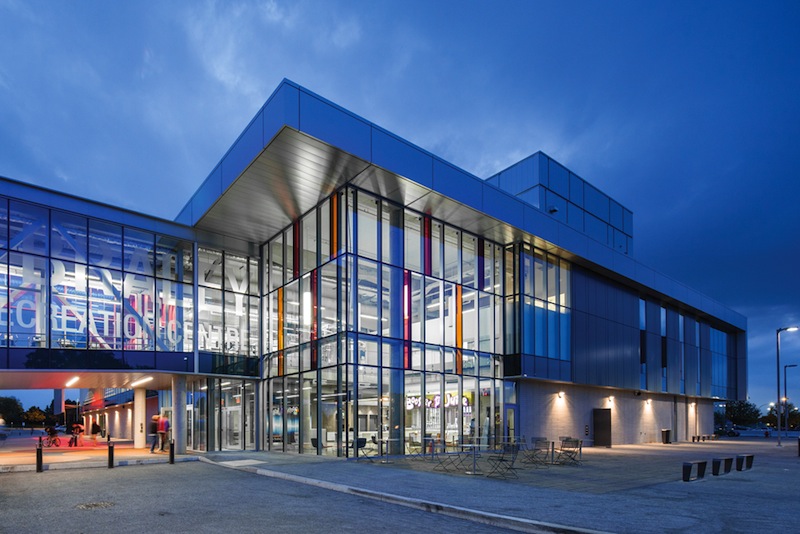 Mohawk College’s David Braley Athletic + Recreation Centre, Hamilton, Ont., faces directly onto a newly defined outdoor plaza. It is distinguished along this edge by a floor-to-ceiling glass wall extending around the upper level fitness center and across an integrated bridge component connected to the student life building. Fritted with a bold graphic pattern, this element acts as a giant banner wall as well as serving an important function in the solar shading of the building. Photo: Scott Norsworthy / courtesy Perkins+Will
Mohawk College’s David Braley Athletic + Recreation Centre, Hamilton, Ont., faces directly onto a newly defined outdoor plaza. It is distinguished along this edge by a floor-to-ceiling glass wall extending around the upper level fitness center and across an integrated bridge component connected to the student life building. Fritted with a bold graphic pattern, this element acts as a giant banner wall as well as serving an important function in the solar shading of the building. Photo: Scott Norsworthy / courtesy Perkins+Will
Building Teams are also reporting the need to focus more carefully on master planning for multiuse recreational facilities, especially where to site them. “Because recreation centers are now considered a primary destination for student life experiences, these centers become figural landmarks on campus and should be considered for the primary locations, such as entries or areas adjacent to student-centric facilities,” says LPA’s Carels.
Don Barnum, a Principal in the higher education sector and Southwest Regional Leader for DLR Group (www.dlrgroup.com), says that his firm typically undertakes a thorough investigation of potential building locations utilizing a comparative analysis of all site features: vehicular and pedestrian access, parking, topography, and utilities, as well as a number of additional objective and subjective features. Each feature is then assigned a score, which is weighted for importance. The resulting fact-based analysis can then be used to assist stakeholders in the decision-making process.
To analyze site options and identify an ideal campus location for a new student recreational center and a stadium expansion and renovation at Simon Frazer University in Burnaby, B.C., Perkins+Will installed cameras in a few key spots to map out where the university’s 30,000-plus students spent the most time walking and gathering. The information collected helped the firm determine where to site the center and how to set up a new stadium entry.
“Using nontraditional methods and newer technology has helped tremendously in determining where to place a building,” says Stephen Sefton, Associate Principal and an expert in planning and designing athletic/recreation facilities with P+W’s Boston office. The firm has even used a remote-controlled drone aircraft to speed up data acquisition and site analysis.
Once a site is selected, a number of factors need to be evaluated before beginning the process of establishing the building’s orientation, footprint, and relationship to other buildings on campus. The process has to consider both indoor and outdoor spaces, says Daniel Kelley, FAIA, of MGA Partners, (www.mgapartners.com). The Philadelphia-based architecture firm often uses a figure-ground technique that graphically highlights areas that are enclosed buildings versus open areas. The heightened visual contrast helps the Building Team study the site plan and determine how to make the best use of enclosed space, circulation patterns, and exterior zones for gathering, circulation, and athletic or recreational use. Kelley cautions that, for a master plan to be fully integrated, every space must be planned, defined, and programmed to make the most of the location.
Other factors that influence the building design: solar orientation, wind and topographical conditions, vegetation, massing of adjacent facilities, transportation characteristics, zoning, and access and connection to services and utilities, says William McCullough, AIA, a Principal with multidisciplinary A/E firm EwingCole (www.ewingcole.com).
FUNCTIONAL ADJACENCIES—RETHINKING A CRITICAL DESIGN COMPONENT
In terms of the building itself, McCullough recommends considering the functional relationships and adjacencies of programs within the facility and then matching them up with access points—entries, service areas, loading points, and the like—as determined by the site. “Our goal as good planners is to understand the growth potential of the facility over time, which means planning for future expansion,” he says.
When it comes to the architectural design itself, Dymecki emphasizes the importance of meshing geographic and cultural context into the project’s form and expression. “Designing a recreational building in Arizona is drastically different from designing one in Boston,” he says.
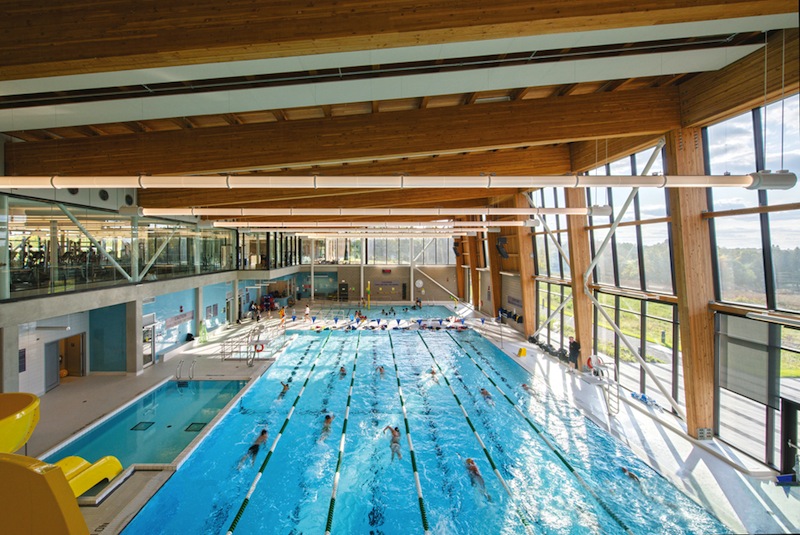 The 57,000-sf Oak Ridges Community Centre, in Richmond Hill, Ont., houses a six-lane swimming pool, along with a 1,200-sf teaching/leisure pool, a gymnasium, a fitness center, an ecocenter, and multi-purpose program rooms. Architect Perkins+Will worked with structural engineer CH2M Hill, mechanical engineer Smith + Anderson, electrical engineer Crossey Engineering, and general contractor AquiCon Construction on the project. Photo: Bob Gundu / courtesy Perkins+Will
The 57,000-sf Oak Ridges Community Centre, in Richmond Hill, Ont., houses a six-lane swimming pool, along with a 1,200-sf teaching/leisure pool, a gymnasium, a fitness center, an ecocenter, and multi-purpose program rooms. Architect Perkins+Will worked with structural engineer CH2M Hill, mechanical engineer Smith + Anderson, electrical engineer Crossey Engineering, and general contractor AquiCon Construction on the project. Photo: Bob Gundu / courtesy Perkins+Will
Project designers must take time to understand the character, culture, and composition of a particular campus before embarking upon the schematic design. “The best projects tend to combine design excellence with the site’s unique features and contextual surroundings,” says Perkins Eastman’s Schiamberg. “A design team with experience in urban design, event overlay planning, landscape, and branded environments is critical to the success of optimal siting and planning.”
Views are another important consideration. These include the views looking at and into the facility as well as the framing of views from within to the exterior. When done well, open vistas and framed scenes to the activity within the facility can enhance the sense of connectivity that is becoming so critical on campuses. Well-considered views can also enhance the psychological connection between the recreational center and the campus context or, in the case of a public sports stadium, the connection between the venue and the surrounding urban area.
In designing the Salvation Army Kroc Community Center in Omaha, Neb., HDR (www.hdrinc.com), along with contractor Kiewit Building Group and construction manager Heritage Services, created three distinct forms to house three programmatic components: 1) a 525-seat assembly hall, 2) an education wing, and 3) an athletic complex with three gymnasiums, an aquatics center, and a fitness center. The designers placed the oval-shaped assembly space prominently in the center so that it would be visible from the surrounding neighborhood as well as from the other building forms, says Bruce Carpenter, AIA, HDR’s Central Region Civic Director.
The same was true for a Salvation Army Kroc Center in Boston’s Dorchester neighborhood, says Michael E. Liu, AIA, NCARB, Vice President and Principal with The Architectural Team (www.architecturalteam.com). The community recreation center required five program zones: 1) culinary arts and food; 2) education and classrooms; 3) performing arts; 4) fitness; and 5) aquatics. The uses are grouped together, but are also open, connected, and accessible to the community, says Liu. The layout also enables ease of supervision for a client base that includes young children and seniors.
Breaking down the scale of the masonry and building’s contemporary metal-panel exterior was a key design focus and a way of responding to the neighborhood, says Liu. The general contractor, Suffolk Construction (www.suffolkconstruction.com), built large volumes containing the gym and pool at the building’s ends or toward the back. Smaller curved masses containing offices or classrooms were used as a kind of infill between these more massive volumes.
The interiors of today’s community centers—these Kroc Centers being outstanding examples—tend toward the highly efficient and fluid to maximize program space and natural light. Hallways are kept to a minimum and lean toward more open circulation zones for community interaction and visitor supervision. For both Kroc Centers, interior visibility helps instill a sense of community awareness while also enhancing safety and security. From the Dorchester facility’s main lobby, it is possible to see clearly through to the gymnasium at the opposite end of the building, thanks to interior and perimeter glazing. Floor-to-ceiling windows in central staff rooms permit views of all program areas.
AN INTEGRATED APPROACH TO DESIGN YIELDS A ‘MORE HOLISTIC SOLUTION’
As the drive for sustainable, high-performance buildings continues, more Building Teams are tapping into the benefits leveraged by an integrated design process and integrated project delivery, or IPD. Due to the rigorous, specialized performance requirements and large size of recreational centers and sports facilities, a strong argument can be made for taking an integrated, interdisciplinary approach.
“By working together from the beginning, the client, design team, vendors, and contractors can prioritize planning and design elements to meet the objectives of a highly functional, yet cost-effective, green building,” says LPA’s Winston Bao, CID, LEED AP BD+C. “The process is streamlined, efficient, and far more effective to support making informed decisions.” Seeking feedback from the building users early on and throughout the project, the IPD team can leverage design and operational insights. In this way, the users become stakeholders.
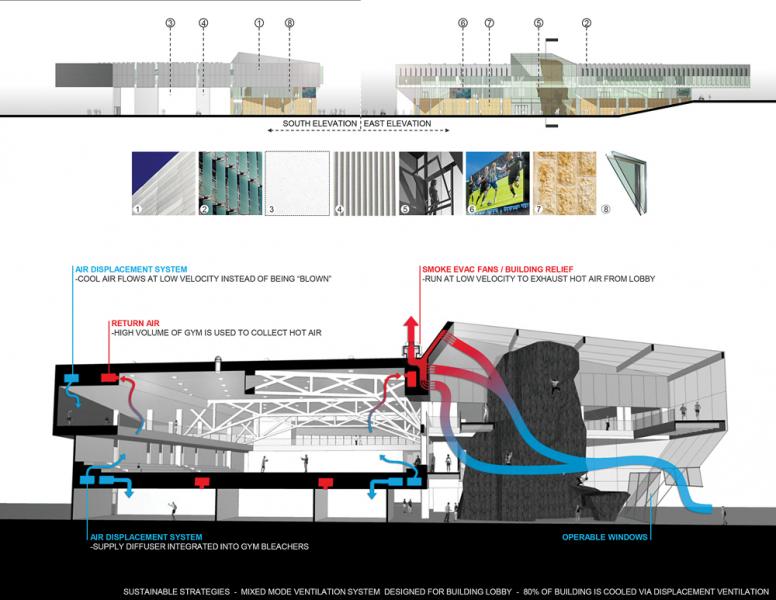 The LPA-led team strategically integrated a displacement ventilation system into the building form for the 165,000-sf Bronco Recreation & Intramural Complex at California State Polytechnic University, Pomona. The mixed-mode system is capable of cooling 80% of the building via natural ventilation. Courtesy LPA Inc.
The LPA-led team strategically integrated a displacement ventilation system into the building form for the 165,000-sf Bronco Recreation & Intramural Complex at California State Polytechnic University, Pomona. The mixed-mode system is capable of cooling 80% of the building via natural ventilation. Courtesy LPA Inc.
Early contractor involvement in the IPD team enables these professionals to exert a positive impact on the building process, budget, and schedule. “The contractor brings knowledge of construction techniques and market costs to guide the design,” says HDR’s Carpenter. “The possibility of identifying long-lead items in the design phase is also a clear advantage for improving the construction schedule.” The contractor will often bring in subcontractors to help figure out the best way to get a function or detail into a project that may have seemed impossible if created with a traditional design approach.
According to DLR Group’s Barnum, additional benefits of IPD include collaborative research and brainstorming to inform a more holistic building solution, early modeling and testing, and a fast-tracked project schedule. Adds Perkins Eastman’s Schiamberg, “The more input and dialogue there is from the get-go among the owner, users, operators, designers, and consultants, the better the output.”
IPD is relatively new, and not all building owners are comfortable with it, cautions Jon Niemuth, AIA, NCARB, LEED, AECOM’s Director of Sports for the Americas. “There is some education required to make this a reality for all clients, but our early adopters are already experiencing benefits which suggest we’re on the right path,” he says. These benefits include improved cost and schedule certainty earlier in the project, fewer construction phase management concerns, better schedule and construction delivery efficiencies, and reduced risk for owners, according to Niemuth.
LPA’s Bao points to the approach taken for the Student Recreation Center at California State University, Northridge. Here, the full design team—including the architect and the electrical, mechanical, and structural engineers—coordinated all the building systems inside one module, somewhat like an airplane fuselage. This prototype was then extended the length of the building. This integrated approach led to the idea of stacking the larger gymnasium spaces onto the second floor and locating the mechanical systems in between the two floors and above the gym space.
Placing courts and elevated jogging tracks on the second and third floors optimized the high-bay ceiling to integrate skylights, displacement ventilation, and a lighting array to balance artificial and natural daylight, according to Bao. This also allowed for the integration of a unique structural system that preserves the uninterrupted long spans in the facility. “The tripod-splayed columns support the structure in multiple directions, minimizing the number of columns required, in addition to breaking down the length of beam spans,” he says. “This design also added value through a more efficient structural system that reduced the weight and size of the main beams.”
The 138,000-sf facility is operating 40% more efficiently than the baseline performance given by the California Energy Commission’s Title 24 building energy-efficiency code, says the firm.
The LPA-led team for the 165,000-sf Bronco Recreation & Intramural Complex at California State Polytechnic University, Pomona, faced similar constraints. Working with an unwieldy site bounded by easements, setbacks, diverse topography, and suboptimal solar orientation, the Building Team maximized the ground-level footprint, extruded the form upward, and expanded horizontally above the site boundaries.
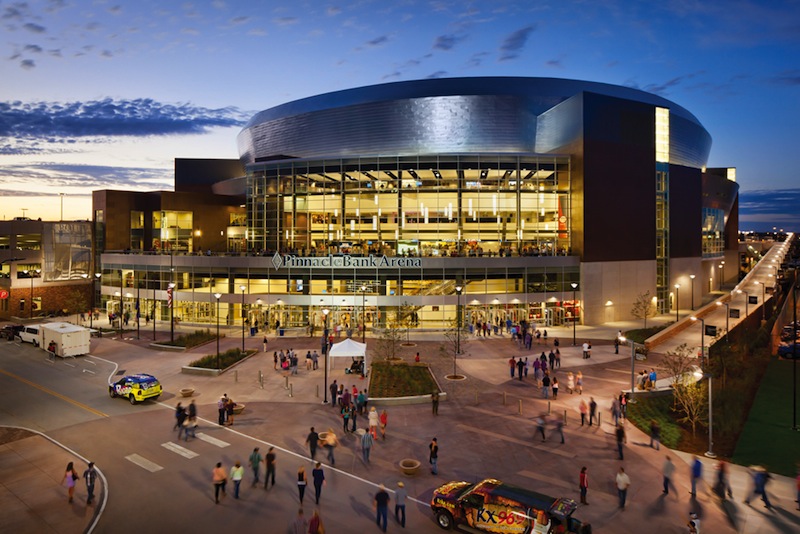 The $181 million, 16,000-seat Pinnacle Bank Arena is fronted by a multi-story glass façade. The 470,000-sf arena, which hosts the University of Nebraska’s basketball teams, is part of the revitalization of the historic Haymarket warehouse district in Lincoln. DLR Group (designer) and BVH Architects (exterior architect) led the Building Team: Buro Happold (SE), Clark Enersen Partners (landscape/hardscape design, parking), M-E Engineers (MEP), and Mortenson/Hampton (GC). Photo: DLR Group
The $181 million, 16,000-seat Pinnacle Bank Arena is fronted by a multi-story glass façade. The 470,000-sf arena, which hosts the University of Nebraska’s basketball teams, is part of the revitalization of the historic Haymarket warehouse district in Lincoln. DLR Group (designer) and BVH Architects (exterior architect) led the Building Team: Buro Happold (SE), Clark Enersen Partners (landscape/hardscape design, parking), M-E Engineers (MEP), and Mortenson/Hampton (GC). Photo: DLR Group
Because the upper floors needed to be much larger than the ground level, LPA’s in-house engineers and architects designed a unique structural system to support the massive cantilevers, which obviated the need for exterior columns, something the university expressly did not want, says Bao. The cantilevers also shade the lower floors, while fritted glass fins protect the generously glazed upper floor from direct sunlight.
In response to Cal Poly Pomona’s requirements, the Building Team designed the structure to frame views of the adjacent campus quad and the greenery and mountains in the distance. “The design team responded by exposing the main façade, primarily composed of glass, and physically breaking the building open at the intersection of the major pedestrian paths converging at the building’s main entry,” says Bao. “This augmented transparency allows the recreation center to become a human billboard of student activity.”
LPA also worked with an IPD team for CSU’s East Bay Recreation and Wellness Center, in Hayward. The project’s tight budget required LPA to come up with an efficient way to condition the two-story, 56,630-sf facility. Pooling the expertise of the architects, engineers, and contractors, the team developed a design using tilt-up concrete panels as part of a trombe wall, which offered a cost-effective structural and enclosure solution. The nine-inch-thick tilt-up panels provide thermal mass to store heat from the sun during the day and release it slowly at night, a logical solution for Northern California’s mild climate. To augment its effectiveness, the southwest-facing wall has a second exterior wall of glass; this traps higher levels of heat, with operable louvers to support natural ventilation. The trombe wall “hyperheats” the concrete, and the wall warms the large interior volume of the CSU East Bay gymnasium.
OLD-FASHIONED SUNSHINE RETURNS TO contemporary SPORTS CENTERS
Daylighting is making a comeback in today’s sports and recreation facilities, recalling the times before the advent of electrical lighting and mechanical heating/cooling systems, when rec centers were lit primarily by the sun and cooled by opening the windows. Today’s more open, transparent façades are preferred by certain user groups, notably college students who want to see and be seen. As a result, more and more municipal and campus facilities are being designed with glazed areas to use daylight for much of the interior illumination.
P+W’s Sefton says that daylighting sports facilities requires careful attention to the programming of the space. “There is a menu of items to be used depending on where you’re located and what you’re trying to achieve,” he says. Generally speaking, double-glazed window systems are an efficient strategy, as they can reduce solar heat gain before it passes through the glass assembly. Frit patterns, louver systems, and shading devices can also work toward this end.
 Amenities in the new Kroc Community Center in Boston include a synthetic turf multiuse athletic field and playground (above), a 250-seat chapel/auditorium, a 500-seat dual-court NCAA regulation gym, a ropes course and climbing wall, a full cardio-fitness center, a recreational pool and outdoor sprayground, and a culinary arts teaching kitchen. Photo: © Andy Ryan / courtesy The Architectural Team
Amenities in the new Kroc Community Center in Boston include a synthetic turf multiuse athletic field and playground (above), a 250-seat chapel/auditorium, a 500-seat dual-court NCAA regulation gym, a ropes course and climbing wall, a full cardio-fitness center, a recreational pool and outdoor sprayground, and a culinary arts teaching kitchen. Photo: © Andy Ryan / courtesy The Architectural Team
Skylights, high clerestory glazing, and translucent windows can be excellent daylighting choices for recreation spaces, by reducing glare and maximizing daylighting in large volumes. In lighting the arena concourse at Bucknell University’s Kenneth G. Langone Athletic & Recreation Center, in Lewisburg, Pa., the team led by EwingCole designed a course of clerestory windows wrapping the building volume. An elevated screen wall between the bowl and the concourse blocks direct light from reaching the players on the basketball court.
“We utilized a similar strategy to add natural light for the adjacent natatorium,” says EwingCole’s McCullough. “By providing a deep arcade, the sunlight never hits the pool deck or water, but provides an indirect light source which is pleasant while reducing lighting demand.”
Tubular daylighting devices are becoming another popular daylighting strategy for sports facilities. LPA has designed several gymnasiums with 48-inch square or 21-inch tubular skylights, spaced 15 to 30 feet on center, accounting for 1-2% of ceiling area. “This design approach provides bright, well-lit recreation environments and generally requires no electric lighting during daylight hours, ” says LPA’s Erik Ring, PE, LEED Fellow.
LED AND HVAC FOR ATHLETICS
Two of the biggest trends in sports facility design have been the rise of LED lighting and the use of more effective ventilation and heating and cooling methods.
LED fixtures and lamps bring long lamp life and durability, good dimming capacity and light quality, and the ability to instantly restrike to sports facility projects. With a light efficacy of 75-100 lumens per watt—about the same as T8 fluorescent tubes—LED lighting also cuts electricity draw with its dimming capability. “Many experts expect that LED lamps will soon surpass the lighting efficacy and energy efficiency of all other electric lighting sources,” says Ring.
“LED technology is here to stay,” says McCullough. “The cost to purchase and install is competitive, and the performance and reduced energy demand are unmatched.” Changing out metal halide lamps to LED sports lighting fixtures has been documented to save more than 60% in lighting energy costs, not to mention reducing heating/cooling loads, he says.
When specifying lighting fixtures for stadiums and arenas, P+W’s Dymecki stresses the importance of making sure that those systems are capable of controlling glare and directing light to where the action is taking place.
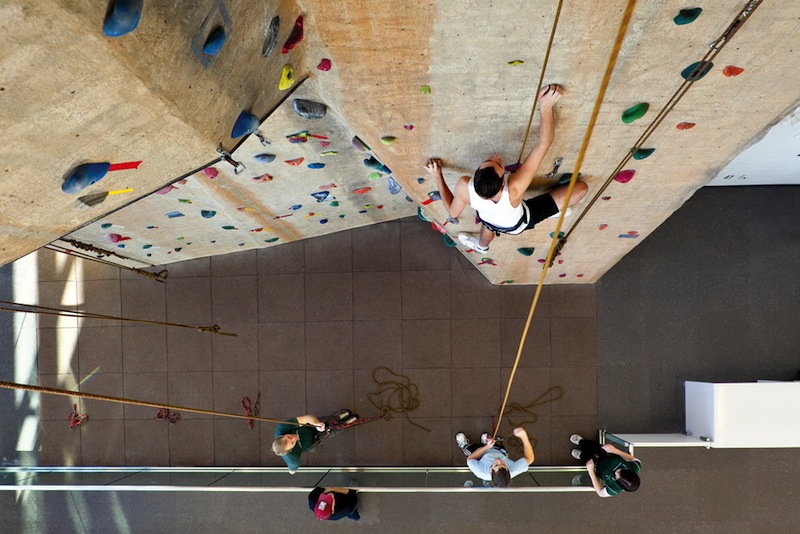 A 28-foot-high rock-climbing wall at the 80,000-sf Trent Community Sport + Recreation Centre, in Peterborough, Ont. The expanded athletic complex carefully integrates a series of newly constructed and renovated spaces to achieve a total regeneration of the facility. Perkins+Will served as architect; Graham Construction and Engineering was the general contractor. Photo: Thomas Lewandovski / courtesy Perkins+Will
A 28-foot-high rock-climbing wall at the 80,000-sf Trent Community Sport + Recreation Centre, in Peterborough, Ont. The expanded athletic complex carefully integrates a series of newly constructed and renovated spaces to achieve a total regeneration of the facility. Perkins+Will served as architect; Graham Construction and Engineering was the general contractor. Photo: Thomas Lewandovski / courtesy Perkins+Will
As for HVAC design, the first step is to determine the extent to which the facility can take advantage of passive strategies, such as solar orientation, solar shading, and natural ventilation “Passive elements can have some of the greatest impact” on HVAC demand, says Schiamberg.
Even the way a facility is laid out can make a difference. Perkins+Will’s Dymecki recommends locating areas such as an indoor track, basketball court, or a fieldhouse on the north side of the structure, which is most protected from the sun. An aquatic center can be sited with a southern or western exposure, where the sun’s rays are the strongest and most direct.
For active HVAC, EwingCole’s McCullough looks for opportunities to implement ventilation control systems to reduce cooling demands, heat exchangers to recover waste heat, and variable-speed drives for HVAC equipment. Because enclosed stadiums and gymnasiums require significant outside air ventilation when fully occupied, but much less when spectators are not present, managing the ventilation air rate via demand-controlled ventilation and outside airflow monitoring and control is important, says LPA’s Ring. Not only will this approach save energy, but it will help ensure that the spaces are comfortable and healthy for fans and athletes.
LPA has found success with thermal displacement ventilation in gymnasium spaces. “We often specify high-volume, low-speed circulating fans in gymnasiums and fitness studios in order to increase air movement during high-intensity activities,” says Ring. Another technique is strategic facility zoning, where the level of heating and cooling is programmed into the building management system based upon the usage patterns and activities that are expected to take place in the different spaces on a given day, says Schiamberg.
HVAC building operating systems require frequent monitoring and adjustment. “Energy monitoring should be done regularly to track energy use and review potential conservation strategies,” advises McCullough. “Recommissioning HVAC systems may save significant costs.” P+W’s Dymecki says locating ductwork and mechanical systems in a gymnasium or arena’s high ceilings presents problems, since it requires dropping conditioned air 30 to 50 feet. “We are now looking at HVAC systems that condition air from the ground up, where we’re not heating or cooling the entire volume, only the space where people are present,” he says. Such an arrangement could require fewer and smaller systems.
Specifying BETTER FLOORS FOR SPORTS AND RECREATION FACILITIES
The flooring industry has developed numerous eco-friendly choices for use in sports and recreation facilities. Bao says it’s not uncommon to see Forest Stewardship Council–certified wood being specified for sport flooring, or rapidly renewable rubber flooring being used for multi-activity courts and studios. Flooring manufacturers are also reducing the volatile organic compounds present in floor system adhesives and coatings.
Designers are also using flooring choices that offer more spring and support, thereby enhancing safety and reducing stress on the legs. AECOM often specifies flooring systems that it uses in gymnasiums, with sleepers and cushions, in the group fitness classrooms and running tracks it designs.
A few flooring manufacturers specializing in materials suitable for health clubs and gymnasiums offers products that not only absorb impact and restore energy but also reduce fatigue. “The non-slip surface protects the user from injuries without hindering movement,” says Bao. “Their products deliver ready-to-go designs that can easily be tailored to suit the fitness programs being offered, including education, music management, merchandising, and environmental branding.”
McCullough says he is seeing improvement in flooring performance for specific activities, and more colors and patterns to choose from. This seems to be motivating sports facilities and recreational centers to invest more in the performance and look of their floors. Of course, budget restraints, especially for operations and maintenance at such facilities, is motivating flooring manufacturers to develop low-maintenance, high-quality flooring systems capable of delivering better performance at a lower cost.
The most positive sign affecting recreational and sports facility design is that athletic and recreational leagues are growing at a robust rate. On some college campuses, well over 50% of the students participate in intramural sports. “Club and intramural program participation has been exploding in the last decade,” says McCullough. “This has translated into increasing demand for additional program space.”
Or, in the words of LPA’s Carels, “Recreation centers are proof that if you build it, they will come.”
EDITOR’S NOTE This completes the reading for this course. To earn 1.0 AIA CES HSW learning units, study the article carefully and take the exam posted at www.BDCnetwork.com/RecCenters.
Public-private partnerships for athletic facilities
Organizations are looking to public-private partnerships (PPP) for creative ways to better fund, utilize, and expand services in community and college recreational centers. In one model, a local healthcare provider may offer health services at the campus or community health and wellness/recreation center. Another example is a sports medicine practice teaming with a college inside a facility on campus. “It’s built as an extension to the main fieldhouse, where both student athletes and other patients are treated on site for rehabilitation,” says William McCullough, AIA, a Principal at EwingCole.
Other communities are combining a recreational center with a library and school on one site. “Dollars and funding have tightened up, so we’re seeing creative ways to share and get utilization out of these facilities,” notes Stephen Sefton, Associate Principal, Perkins+Will.
P+W’s David Dymecki, AIA, says, “In sharing a gym and sharing a theater, the community is also building and maintaining fewer buildings, while benefiting from greater use, efficiencies, and cost savings.”
Broadening the game-day experience for fans
To leverage the community spirit and energy of live sporting events, universities are creating fan zones around their sports venues to expand the game-day experience to include pre- and post-game events, says Jon Nieumuth, AIA, NCARB, LEED, AECOM’s Sports Director for the Americas.
“We have worked with a number of institutions to zone these outdoor spaces to specific groups—families, students, tailgaters—to cater to their specific needs,” he says. Fan zones not only generate interest in the events, they increase attendance and provide the athletic department with additional revenue, he notes.
Bruce Carpenter, AIA, HDR’s Central Region Civic Director, says that the connections from fan to fan and from player to fan are much stronger at a live event. “Sports facility design needs to continue to improve those connections to make the experience more memorable,” he says.
Quarter-pounder legacy: Salvation Army Kroc Centers
At her death in 2003, Joan Kroc, widow of McDonald’s founder Ray Kroc, left $1.5 billion to the Salvation Army to create community centers throughout the U.S. The new 120,000-sf Kroc Community Center in Omaha, Neb., is one such example. Highlights of the HDR-designed center:
• An assembly hall decked out with a professional sound system and
theatrical lighting, with seating for 525.
• A fellowship hall for hosting social events.
• An eight-classroom education center.
• A gymnasium complex with two collegiate-sized courts and one smaller-scale court.
• An aquatics center with a six-lane, 25-yard competition pool and a zero-depth recreation pool.
• A 4,500-sf fitness center and 1,500-sf exercise room.
• A chapel with seating for 125 people.
• An outdoor festival plaza for hosting large-scale public gatherings.
Cornhuskers’ Pinnacle Bank Arena: integrated design in action
As part of the redevelopment of the historic Haymarket District in Lincoln, Neb., DLR group designed the new 470,000-sf, 16,000-seat Pinnacle Bank Arena as a high-quality, multi-purpose venue. The multi-story, glass-fronted lobby lets passersby see what’s going on inside and patrons to see through to the bustling neighborhood of converted warehouses outside.
The $179-million arena is used primarily for University of Nebraska men’s and women’s basketball games, but it also hosts concerts, ice events, and state high school tournaments.
DLR Group utilized an integrated project process to ensure the best possible outcome. According to DLR’s Don Barnum, Principal and Higher Education Market Sector Southwest Regional Leader, the designers brought in user stakeholders in programming and design workshops early on in the design process and held community workshops to solicit feedback from the University of Nebraska and Lincoln residents.
DLR also brought in the construction manager, Mortenson/Hampton, at the start of design. The site was very tight, with adjacent rail lines that could impinge on the arena’s footprint. Involving the CM early in the sequencing of construction, budget, and schedule was critical.
In addition to the main concourse and supporting areas, a lower seating bowl offers 832 club seats, 36 executive suites, 20 loge boxes, and two private club lounges, plus a team store and 73 concession points of sale.
The upper deck features a unique “split-deck” design that lets patrons on the upper concourse view the event floor below. The split upper concourse also allows the seats located in the top bowl to pull closer to the floor, thereby creating a wall of fans surrounding the event. The design also means fans don’t have to climb long flights of stairs to get to the high-up seats.
Barnum says the integrated team process resulted in a project that was delivered on time and under budget.
Related Stories
Giants 400 | Oct 20, 2017
Top 40 sports architecture firms
Populous, HOK, and HKS top BD+C’s ranking of the nation’s largest sports sector architecture and AE firms, as reported in the 2017 Giants 300 Report.
Sports and Recreational Facilities | Sep 27, 2017
A soccer team’s fan base could play an integral role in its new stadium’s design and operations
Sacramento Republic FC and HNTB are conducting a contest where the public can submit concept ideas.
Sports and Recreational Facilities | Sep 11, 2017
Mid-size, multi-use arenas setting a trend for the future
While large 20,000-seat sports venues aren’t going away, mid-size venues provide advantages the big arenas do not in a time of budget constraints and the need for flexibility.
AEC Tech | Aug 25, 2017
Software cornucopia: Jacksonville Jaguars’ new practice facility showcases the power of computational design
The project team employed Revit, Rhino, Grasshopper, Kangaroo, and a host of other software applications to design and build this uber-complex sports and entertainment facility.
Sports and Recreational Facilities | Aug 18, 2017
Video: Designing the ideal rugby stadium
HOK invited four world-class rugby players into its London studio to discuss what they would like to see in the rugby stadiums of the future.
Sports and Recreational Facilities | Aug 16, 2017
Detroit Pistons Performance Center hopes to invigorate the community, create an NBA championship team
The facility will be incorporated into the community with public spaces.
Sports and Recreational Facilities | Jul 17, 2017
A new Rec Centre in Toronto links three neighborhoods
Community engagement impacts its design and programming.
Codes and Standards | Jun 21, 2017
Senate bill would prohibit tax money for sports stadium projects
Bipartisan legislation would prevent use of municipal bonds by pro teams.
Building Team Awards | Jun 8, 2017
Team win: Clemson University Allen N. Reeves Football Operations Complex
Silver Award: Clemson gets a new football operations palace, thanks to its building partners’ ability to improvise.
Sports and Recreational Facilities | May 19, 2017
Construction of $2.6 billion L.A. football stadium delayed by heavy rains
The Rams and Chargers won’t be able to move in until the 2020 season.


